 |
 |
 |
| |
Asians, Blacks, Young People Fall Short in US Viral Suppression Comparison
|
| |
| |
9th IAS Conference on HIV Science (IAS 2017), July 23-26, 2017, Paris
Mark Mascolini
Asians and blacks lagged whites in viral suppression rate in an analysis of a large US healthcare system, and younger groups lagged people 65 or older [1]. But blacks had improving odds of viral suppression across the 2014-2016 study.
Stronger and more convenient antiretroviral regimens led to surging viral suppression rates over the past decade. Ample research shows, however, that suppression rates often differ by age, gender, race, and other factors. The Kaiser Permanente healthcare system in Maryland, Virginia, and Washington, DC, offers members equal access to care, and Kaiser has implemented strategies to address disparities in care. Kaiser investigators conducted this study to see whether viral suppression and pharmacy fill rates differed in subgroups by age, gender, race/ethnicity, or HIV risk factor.
This analysis focused on all HIV-positive people at least 18 years old and receiving care at a Kaiser center in 2014-2016. The primary outcomes were viral suppression (viral load below 200 copies at last measure of year) and antiretroviral use (2 or more antiretroviral fills in the year). A logistic model using generalized estimating equations and adjusted for demographic variables determined odds of viral suppression or pharmacy fill in analyzed subgroups.
The analysis involved 3395 people, including 1000 women, 2510 blacks, 60 Asians, 444 18-to-29-year-olds, 1387 30-to-49-year-olds, 1305 50-to-64-year olds, and 259 people 65 or older. Overall viral suppression rates were 76.0% in 2014, 76.7% in 2015, and 78.9% in 2016. Respective pharmacy fill rates were 78.4%, 81.0%, and 80.8%.
Compared with people 65 or older, all three younger age groups had independently lower odds of viral suppression: odds ratio (OR) 0.54 for 18-to-29-year-olds, 0.56 for 30-to-49, and 0.72 for 50-64. Pharmacy fill rates tended to be lower in the youngest age group (OR 0.63, 95% confidence interval [CI] 0.40 to 1.00) and improved over time in the 30-to-49 group (OR 1.34) and the 50-to-64 group (OR 1.30). Compared with men, women had lower odds of pharmacy fills (OR 0.76) but not lower odds of viral suppression.
Compared with whites, Asians had sharply lower odds of viral suppression (OR 0.15). Blacks also had lower odds of suppression than whites (OR 0.41), but Hispanics did not. The viral suppression rate improved over time in blacks (OR 1.26) but not in Asians. Compared with whites, blacks had lower odds of pharmacy fills (OR 0.57), but Asians and Hispanics did not. Fill rates tended to improve over time in blacks (OR 1.17, 95% CI 0.99 to 1.39).
Compared with men who have sex with men, heterosexuals and injection drug users did not have lower odds of viral suppression or pharmacy fills. Viral suppression rate improved over time in injection drug users (OR 1.20, 95% CI 1.00 to 1.45).
The researchers concluded that viral suppression and pharmacy fill rates generally improved over time, especially in blacks, but "many groups still fall short compared with reference populations," particularly younger people, Asians, and blacks for viral suppression.
Reference
1. Horberg M, Blank J, Rubenstein K, Hurley L, Kadlecik P, Silverberg M. Changes in antiretroviral therapy and maximal viral suppression over time by age, gender, race/ethnicity, and HIV risk among HIV-infected patients in an integrated health system in the United States. 9th IAS Conference on HIV Science (IAS 2017), July 23-26, 2017, Paris. Abstract WEPED1419.
-----------------------
Changes in Antiretroviral Therapy (ART) and Maximal Viral Suppression over Time by Age, Gender, Race/Ethnicity, and HIV Risk among HIV-Infected Patients in an Integrated Health System in the United States
Michael Horberg1, Jackie Blank1, Kevin Rubenstein1, Leo Hurley2, Peter Kadlecik3, Michael Silverberg2
1Mid-Atlantic Permanente Research Institute, Kaiser Permanente Mid-Atlantic States, Rockville, MD, USA; 2Division of Research, Kaiser Permanente Northern California, Oakland, CA, USA; 3Kaiser Permanente Mid-Atlantic States, Washington, DC, USA;
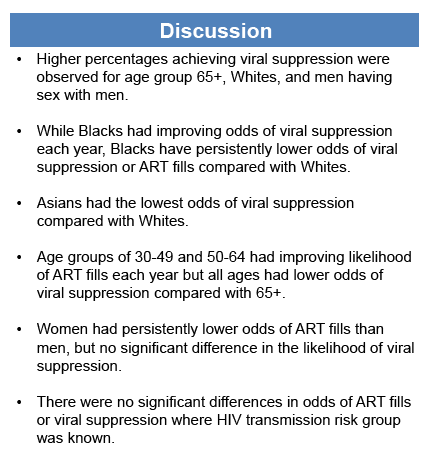
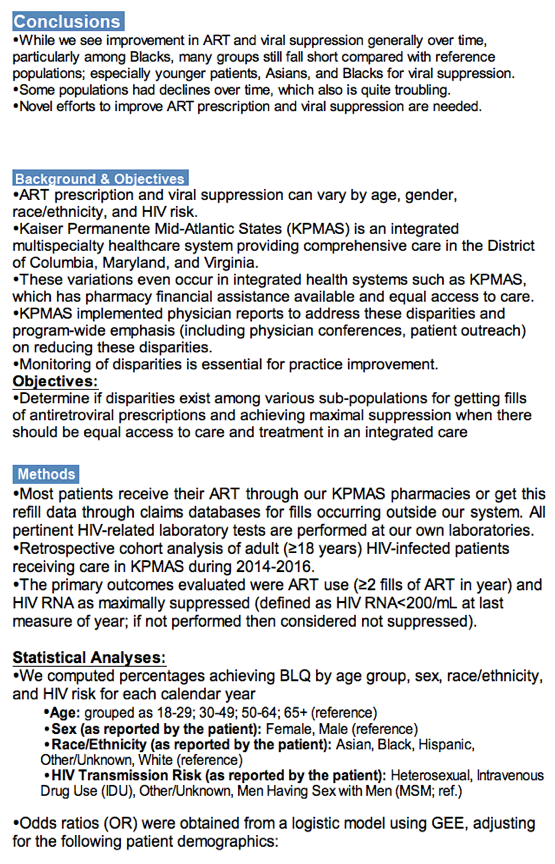
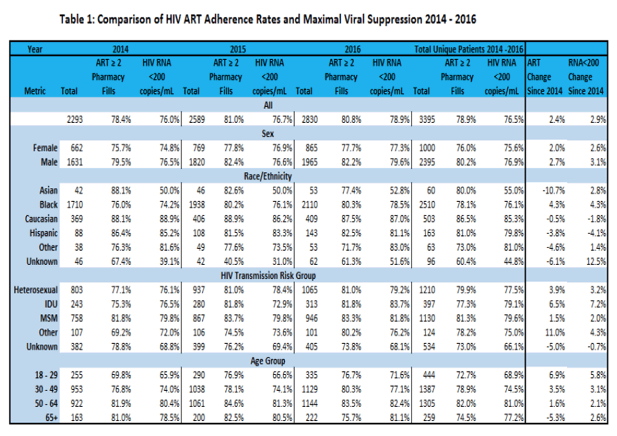
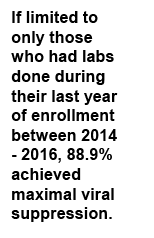
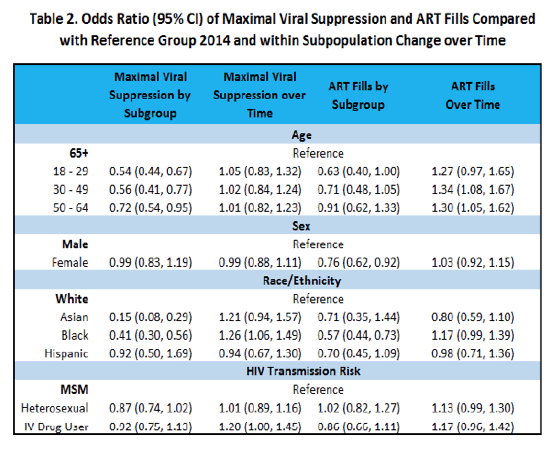
|
| |
|
 |
 |
|
|